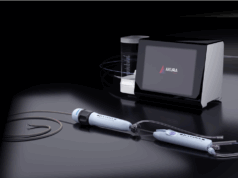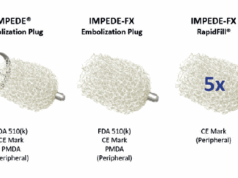
There is still room for improvement in trying to solve ineligibility due to access, navigational challenges and placement inaccuracies in EVAR, Gioachino Coppi, University of Modena and Reggio Emilia, Italy, stated at the VEITHsymposium (14–18 November 2012, New York, USA). Coppi presented one-year results with the new customisable, ultra-low profile Incraft abdominal aortic aneurysm stent graft system, designed to address these issues. Coppi said the one-year data were “encouraging”.
Coppi presented the one-year results from the INNOVATION (A multicentre, open label, prospective, non-randomised study of Incraft in subjects with abdominal aortic aneurysms) study on behalf of the study investigators. The study was designed to assess the safety and efficacy of the Incraft device for the treatment of patients with abdominal aortic aneurysms at investigational sites in Germany and Italy.
Incraft (Cordis) is a three-piece modular system, with supra-renal fixation, segmented nitinol stents and low porosity polyester graft. In terms of customisation, Coppi said, the device enables partial proximal re-positioning bilateral in situ length adjustment up to 3cm. “It is a ‘few fits most’ surgical graft concept,” he noted. The device provides an integrated delivery system with a profile equivalent to that of a regular 13F catheter sheath introducer (14F outside diameter). “Incraft has extreme flexibility, a micrometric deployment system and a thin and resistant endograft wall,” he added. “This can increase applicability and enable treatment with local anaesthesia, percutaneous access, reduced trauma and early discharge.”
“The question is, does low profile mean low durability?” Coppi asked. Incraft, he continued, has been tested in vitro and the technical results, in comparison with other endografts, demonstrated better performance in terms of corrosion, fracture and migration.
In INNOVATION, the primary endpoints were successful deployment at desired location and absence of endoleaks (I, III and IV) post procedure and absence of device or procedural related major adverse events on month post procedure. The major secondary endpoints were absence of aneurysm enlargement ≥5mm, absence of graft migration ≥10mm, quality of life, absence of fracture and absence of major adverse events and endoleaks types I, III and IV at three, six and 12 months and annually out to five years.
The study enrolled 60 patients (mean age 74.5±6.9 years, 95% male) and, according to Coppi, a high percentage of patients had severe morphologies.
The results showed that at one-year follow-up, there were zero incidences of sac enlargement, endoleaks (type I, III or IV), device or procedure related major adverse events, stent graft migrations or stent fractures. All stent grafts remained patent at one-year follow-up. Secondary interventions were performed in two cases.
Coppi noted that, at one year, the mean aneurysm shrinkage rate was 6.6%. “In our experience in Modena we have seen shrinkage in all patients,” he said. “For the first patient in the trial, who has reached two years of follow-up, the shrinkage rate was 40%.”
“The INNOVATION trial results to date demonstrate favourable one year clinical outcome of the Incraft system with abdominal aortic aneurysms. The innovative technologies of the Incraft system make it a valuable option to treat aneurysm patients in the future, including those that are currently not considered eligible for endovascular treatment,” said the study’s principal investigator, Dierk Scheinert, head of the Department of Medicine, Angiology and Cardiology at Park-Krankenhaus Hospital in Leipzig, Germany.
Incraft is also being investigated in a US-Japan pivotal clinical study, INSPIRATION. Coppi told delegates that 49 patients had been enrolled in the 190-patient trial at the time of the VEITHsysmposium. The trial Physician Advisory Panel includes Corey Teigen, Department of Interventional Radiology, Sanford Medical Center, Fargo, USA, Takao Ohki, chairman of the Department of Surgery at Jikei University School of Medicine in Tokyo, Japan, and Robert Bersin, medical director, Endovascular Services, Swedish Medical Center, Seattle, USA. The INSPIRATION pivotal study is being led by principal investigators Ohki and Michel S Makaroun, professor and chair of the Division of Vascular Surgery at the University Of Pittsburgh School Of Medicine.
The Incraft device is approved for investigational device use only and it not for sale anywhere in the world.













